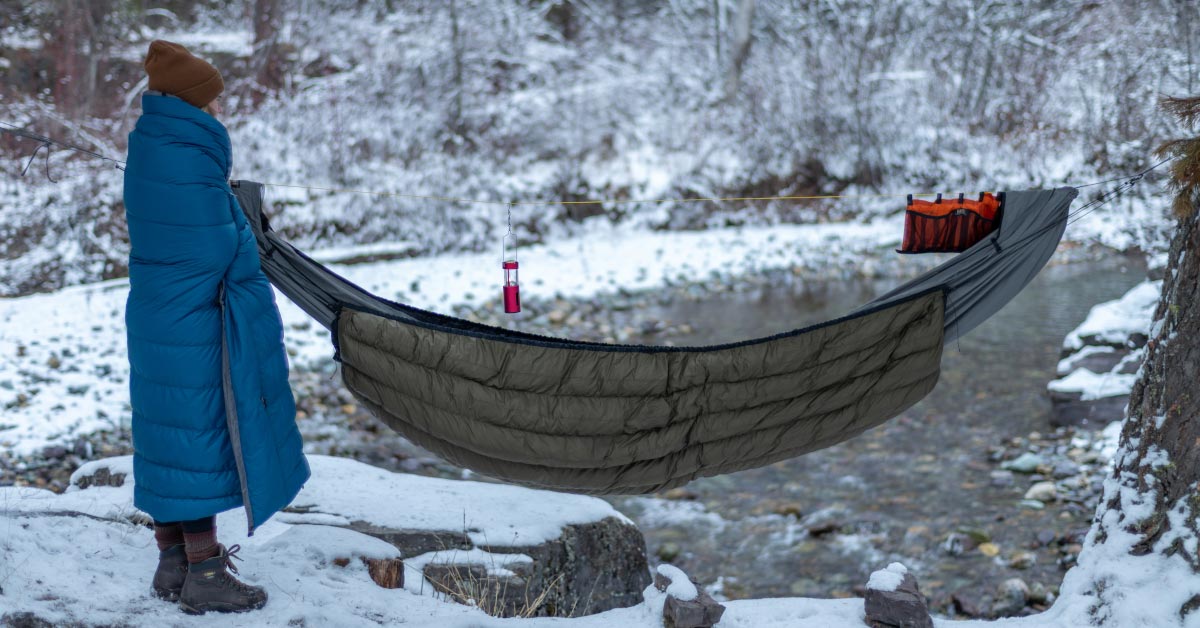Why Down Outperforms Synthetic Insulation

When it comes to the age old, backcountry gear rivalry of down vs. synthetic insulation for sleeping bags and quilts, there is a clear winner: down. But give it a Google Search and you’ll find articles that present the two insulation types as if they’re equal performers, deserving the same amount of your consideration, and expounding that it’s up to you, the reader, to choose what’s right according to your needs. Let us be abundantly clear and offer a shortcut – For use in sleep systems, down outperforms synthetic insulation in almost every possible way and in almost every possible backcountry use case. If you value product performance at all, choose a responsibly sourced down product.
Here are the six main reasons why we believe down products outperform synthetics, and why your next quilt should be down-filled.
1. Down is warmer. Ounce for ounce, down insulates better than synthetic materials. Both function by creating a lofted buffer zone of neutral temperature air trapped amongst the down plumes or synthetic batting that prevents heat from radiating out. The thicker and taller the lofted buffer, the harder it is for heat to escape. Put simply, down insulates better because it’s puffier. It really is that simple.
2. Down is lighter. Because an ounce of down is puffier than an ounce of synthetic insulation, a sleeping bag or quilt requires less of it to achieve the same temperature rating. Therefore, when comparing bags or quilts of similar temperature ratings, you’ll always find that the down option is lighter weight, yet equally warm. In fact, the ultralight community endorses down so wholeheartedly that it is nearly impossible to find a synthetic-insulated, ultralight style backpacking quilt.
3. Down is more packable. Not only is down puffier than synthetic insulation when laid out, it’s also way more compressible when stuffed in a pack. And because it’s so airy and malleable, it does a much better job of filling in empty space pockets (ex. between the shelter and cook pot) than compressed synthetics bags, which, when stuffed down, are comparable in shape to a lumpy basketball. The main benefit to the user here is that, with down, you can bring a smaller and lighter backpack (compounding the weight savings), or save more room for other gear, food, or luxury items.
4. Down lasts longer. Another great benefit of down is its longevity. Down plumes in sleeping bags and quilts can withstand years of the camping use cycle (stuff, fluff, sleep, restuff, repeat) that will more easily harm synthetic insulations which lose their lofting properties (and degrade their temp rating) at a much faster clip as they shuffle in and out of compressed states. And While both materials suffer from long term wear and tear, down also takes better to restorative washes. Because dirt and body oil actually cause more loft reduction (short and long term) to the plumes than repeated compressions, down’s biggest longevity concern is relatively easily managed. While synthetics can also be washed for a smaller, but still positive restorative effect, synthetic’s slow but steady degradation of loft is the ultimate unsolvable problem. To maximize your down’s lifespan, make sure to store your insulated gear uncompressed in a loose, breathable, cotton bag, like this one, that comes complimentary with every Hammock Gear quilt.
5. Down is a better investment. Sure, down products are more expensive than synthetics to purchase. But when you factor in the longer lifespan on top of its performance benefits, down offers a much more compelling overall value. Replacing your sleep system every five years instead of every three years will save tons of money over the course of a life time!
6. Down still insulates when wet. Barring a complete and thorough soaking in which the plumage loses all loft, a damp or wet down quilt or sleeping bag will still keep you warm. The bottom line is that sleep setups are virtually never exposed to water anyway. With a combination of good shelter, good dry bags, and good camp management, your quilt or bag is unlikely to ever get any wetter than damp.
Well there you have it! Down is a better insulator than synthetics, pretty much across the board. And we really mean it! At Hammock Gear, we believe so strongly in the performance benefits of down that we don’t even offer synthetic insulation. So next time you’re shopping for a sleeping bag or quilt, skip the synthetics and get down.

